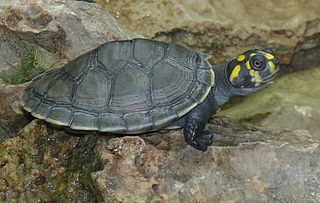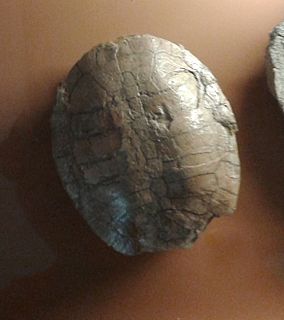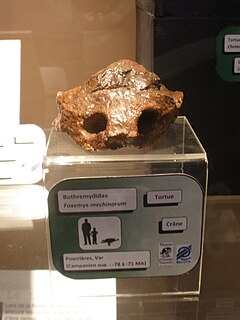
Podocnemididae is a family of pleurodire (side-necked) turtles, once widely distributed. Most of its 20 genera and 30 species are now extinct. Seven of its eight surviving species are native to South America: the genus Peltocephalus, with only one species ; and the genus Podocnemis, with six living species of South American side-necked river turtles. There is also one genus native to Madagascar: Erymnochelys, the Madagascan big-headed turtle, whose single species E. madagascariensis.

Palaeosaurus is a genus of indeterminate archosaur known from two teeth found in either the Magnesian Conglomerate or the Avon Fissure Fill of Clifton, Bristol, England. It has had a convoluted taxonomic history.

Bothremydidae is an extinct family of side-necked turtles (Pleurodira) known from the Cretaceous and Cenozoic. They are closely related to Podocnemididae, and are amongst the most widely distributed pleurodire groups, with their fossils having been found in Africa, India, the Middle East, Europe, North America and South America. Bothremydids were aquatic turtles with a high morphological diversity, indicative of generalist, molluscivorous, and piscivorous diets. Unlike modern pleurodires, which are exclusively freshwater, bothremydids inhabited freshwater, marine and coastal settings. Their marine habits allowed bothremydids to disperse across oceanic barriers into Europe and North America during the early Late Cretaceous (Cenomanian). The youngest records of the group are indeterminate remains from Saudi Arabia and Oman, dating to the Miocene.

Cearachelys is an extinct genus of pleurodiran turtle which existed some 110 million years ago. The genus is monotypic, with only type species Cearachelys placidoi known.
Kinkonychelys is an extinct genus of side-necked turtle which existed in Madagascar during the Late Cretaceous period. It contains the single species Kinkonychelys rogersi, named in honor of its discoverer, Raymond R. Rogers. The genus and species are based on UA 9748, a nearly complete skull, which represents the first turtle skull described from the pre-Holocene era in Madagascar. A number of isolated skull and jaw bones have also been assigned to K. rogersi. These specimens were found in rocks of the Maastrichtian-age Maevarano Formation in the Mahajanga Basin of northwestern Madagascar. Another specimen, FMNH PR 2446, is speculated to represent another species, currently known as Kinkonychelys sp., but consensus on its distinction from K. rogersi remains unclear.
Kurmademys is an extinct genus of side-necked turtle which existed in India during the late Cretaceous period. It was first named in 2001, by Eugene S. Gaffney, Sankar Chatterjee, and Dhiraj K. Rudra, and contains the species Kurmademys kallamedensis. The species name is derived from the Kallamedu Formation of southern India, where the type specimen of the genus was discovered. It was assigned to the family Bothremydidae.

Foxemys is an extinct genus of bothremydid turtle that was discovered at Fox Amphoux, France and also Hungary and Spain. Its skull and shell structure is similar to Polysternon. Two species are in the genus: F. mechinorum and F. trabanti.

Polysternon is a genus of turtles in the extinct family Bothremydidae. It was described by Portis in 1882, and contains the species P. provinciale, which existed during the Cretaceous of what is now France; P. atlanticum, which existed during the Cretaceous at Laño in what is now Spain, and a new species, P. isonae, from the Late Maastrichtian of Spain.

Galianemys is an extinct genus of turtle in the family Bothremydidae, discovered in the Kem Kem Beds.
Elochelys is an extinct genus of bothremydid pleurodiran turtle that was discovered in the Fuveau Basin, France. The genus consists solely of type species E. perfecta, though a second species was reassigned to the genus Iberoccitanemys.
Ilatardia is an extinct genus of bothremydid pleurodiran turtle that was discovered in the Farin Doutchi Formation of Niger. The genus consists solely of type species I. cetiotesta.
Arenila is an extinct genus of bothremydid pleurodiran turtle that was discovered in the Western Desert of Egypt. The genus consists solely of type species A. krebsi.
Azabbaremys is an extinct genus of bothremydid pleurodiran turtle that was discovered in the Teberemt Formation of Mali. The genus consists solely of the type species Azabbaremys moragjonesi.
Motelomama is an extinct genus of bothremydid pleurodiran turtle that was discovered in the Ypresian Salina Group near Negritos, Peru. The genus consists solely of type species M. olssoni.
Phosphatochelys is an extinct genus of bothremydid pleurodiran turtle that was discovered near Oued Zem, Morocco. The genus consists solely of type species P. tedfordi.
Rhonthonemies is an extinct genus of bothremydid pleurodiran turtle that was discovered in Morocco. The genus consists solely of type species R. brinkmani.
Ummulisani is an extinct genus of bothremydid pleurodiran turtle that was discovered in the Mrah Iaresh locality of Morocco. The genus consists solely of type species U. rutgerensis.
Labrostochelys is an extinct genus of bothremydid pleurodiran turtle that was discovered in the Ouled Abdoun Basin, Morocco. The genus consists solely of type species L. galkini.
Sindhochelys is a genus of extinct turtle of the family Bothremydidae. It lived during the early Paleocene in what is known Sindh, Pakistan. The genus was discovered in the Khadro Formation and named in December of 2021. The genus represents the first known member of its family in Pakistan.The family Bothremydidae lived from the Cenomanian of the early Cretaceous to the Miocene epoch.






